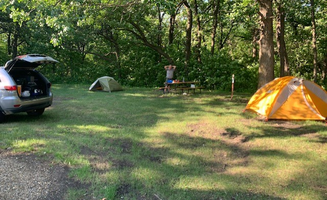Camping sites near Cayuga, North Dakota feature a mix of prairie ecosystems and wooded areas across Richland and Sargent counties. The region sits at approximately 1,200 feet elevation with a continental climate characterized by warm summers and cold winters. Summer nights typically cool down to the 50s-60s°F even when daytime temperatures reach the 80s-90s°F, making sleeping conditions generally comfortable for tent campers.
What to do
Hiking prairie trails: At Jorgen's Hollow Campground, campers can access the North Country Trail directly from camp. "The North Country Trail goes right through camp. Hike (or ride your horse) it into the grasslands or the other way to join more trails," notes Art S. The nearby trails provide opportunities to view native prairie flowers and wildlife.
Fishing opportunities: Dead Colt Creek Rec Area offers lake fishing just outside Lisbon. "The lake is very pretty. The swimming area is very nice. They have full bathrooms with showers," writes Teresa T. The lake is stocked with fish and provides a convenient spot for anglers.
Stargazing: The open prairie landscape creates excellent night sky viewing conditions. According to Rachel O. at Jorgen's Hollow Campground, there's "Great stargazing. Clean water and vault toilets. Great access to the NCT." The limited light pollution in this rural area makes it ideal for astronomy enthusiasts.
Swimming beaches: Several campgrounds feature swimming areas for cooling off during summer months. Dead Colt Creek has a designated swimming area that campers describe as "very nice," while other lakes in the region provide additional water recreation options.
What campers like
Quiet atmosphere: Many camping areas near Cayuga remain uncrowded, especially midweek. At Sheyenne National Grassland, one reviewer appreciated the solitude: "We dispersed camped for 1 night while walking along the North Country trail. It is a quiet and safe, we parked at the trail head and intended to hike to mirror lake but didn't make it in that far."
Wildlife encounters: The grasslands and wooded areas support diverse wildlife. At Hankinson Hills Campground, visitors often hear coyotes and see prairie birds. "What is unique about this place is that is an original remnant of the oak/grass prairies that used to cover extensive areas where the forest met the plains," notes Doug W.
Well-maintained facilities: Despite their remote location, many campgrounds receive praise for cleanliness. According to Katie L. at Hankinson Hills Campground: "Well maintained campground, has water and multiple vault toilets. There's a loop for horse camping and a loop for non horse camping. Each site has a fire ring and a nice table, most spaces have trees to provide shade."
Unique ecosystem: The tall grass prairie represents a rare habitat type that campers appreciate. In the Sheyenne National Grassland, John found "a little paradise" while dispersed camping, noting he was "doing the dispersed camping right in the oak valley next to the 1212."
What you should know
Weather considerations: The prairie environment can bring sudden weather changes. Wind is a common factor, and summer thunderstorms develop quickly. Campers should secure tents properly and have rain gear accessible. As one camper at Jorgen's Hollow noted: "In the evening the best part was listening to the trees in the breeze."
Biting insects: Summer brings mosquitoes and biting flies, particularly in wooded areas. A camper at Hankinson Hills Campground mentioned: "Only downside was the abundance of biting flies and mosquitoes." Bug spray is essential from June through August.
Seasonal availability: Most developed campgrounds operate from May through September or early October. Dead Colt Creek Rec Area specifically operates "May 1 to September 30," while dispersed camping in the grasslands remains available year-round, weather permitting.
Livestock presence: The Sheyenne National Grassland allows cattle grazing, which means campers share the landscape with livestock. "There are cows around the prairie which leads to cattle gates along the trail, just a quick flip up of the gate and you are on your way! I recommend selecting an area where the cows are not currently in," advises Christina M.
Tips for camping with families
Playground access: Several campgrounds feature play areas for children. At Forman City Park and Campground, one camper noted it's "Small but convenient" with "3 spots with electric and bathrooms." The park setting provides play opportunities for kids.
Swimming options: For families with children, Dead Colt Creek Rec Area offers a designated swimming beach that's well-maintained. "The swimming area is very nice. They have full bathrooms with showers," according to a recent visitor.
Educational opportunities: The unique grassland ecosystem provides learning experiences about prairie ecology. One camper at Sheyenne National Grassland shared: "My first and not going to be the last campout here. Beautiful sites, trails, very friendly and knowledgeable ranger." Rangers can provide information about local plants and animals.
City park alternatives: Several towns near Cayuga offer small municipal campgrounds that work well for families needing facilities. Teresa T. described Milnor City Park: "It's a few parking spots near a small park right inside the town. They're nice summer in the shade. And I think milner's a pretty town."
Tips from RVers
Site selection: RV campers should research site dimensions before arrival. At Hankinson City Park, Always C. reports: "4 grass spots with 30 amp electric picnic table and trash cans. Dump station at the pay box but no water."
Road access: Some camping areas require navigation on gravel roads. For Hankinson Hills Campground, Claudia H. noted: "Road in was good gravel. Picnic tables, fire rings and pit toilets. $10/night." Most roads remain passable for standard RVs, though heavy rain can affect conditions.
Water fill locations: Several campgrounds lack water hookups, requiring advance planning. At Hankinson City Park, a camper mentioned they "Found a business that let us fill our tanks," highlighting the need to identify water sources before arrival.
Leveling requirements: Many sites require some leveling for RVs. Silver Lake Rec Area received this note from a camper: "Our site had a gravel pad that required very little leveling with very nice grass surrounding it." Carrying leveling blocks is recommended for most area campgrounds.





